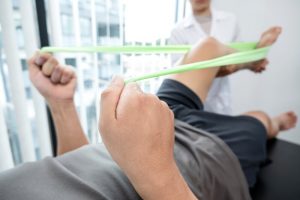The Anterior Cruciate Ligament (ACL) is one of the most injured ligaments. An ACL injury can be a result of three distinct types of mechanism – direct contact, in-direct contact, and non-contact with non-contact injuries identified as the most prevalent and are caused by forces generated within the athlete’s body.
Patients with ACL tears complain of hearing or feeling a pop, swelling, significant pain, and joint instability. ACL injuries also occur along with damage to articular cartilage, meniscus, or other ligaments although they can also be an isolated injury.
An athlete changing direction, using a cutting movement (cut and plant), resulting in a quick change in direction or speed (deceleration) with the foot firmly planted, is a common mechanism that causes the ACL to tear.
ACL injuries have also been related to quick deceleration movements, such as planting the afflicted leg to cut and change direction, landing from a jump, pivoting, twisting, and direct impact to the front of the tibia.
Female athletes have a higher incidence for ACL injury due to low training age and physical training, reduced muscular strength, and neuromuscular control when compared to male athletes. Other factors to consider include pelvic and lower extremity variations, increased ligament looseness, and estrogen’s influence on ligament characteristics.
Given each ACL injury is different in presentation and outcome, rehabilitation protocols should be individualised to each athlete.
According to Rodriguez et. al (2021) ACL ruptures that do not have surgical intervention have a poorer prognosis in returning to high level activity. Athletes have difficulty participating in cutting or pivoting-type sports following a total ACL tear, while others have instability with typical tasks such as walking.
However, in a study by Meuffels et al. that compared the long-term outcomes of highly active patients with ACL ruptures treated surgically versus non-surgically concluded that at the time of the examination during follow-up, the patients who had undergone surgical treatment had significantly improved knee stability. However, at a 10-year follow-up, both treatment options show comparable patient outcomes, therefore, no statistical difference between patients treated conservatively or surgically was evident.
Although ACL injuries manifest with such a wide range of symptoms, leading to the practitioner to modify rehabilitation program to individual patient demographics, account for the severity of the injury, and the patient’s long-term recovery profile.
Athletes with an ACL tear should be advised that surgical repair is not the only option for continuing sporting activities; a conservative approach consisting of a strict and vigorous rehabilitation plan can suffice.
References
- Rodriguez K, Soni M, Joshi P K, et al. (December 06, 2021) Anterior Cruciate Ligament Injury: Conservative Versus Surgical Treatment. Cureus 13(12): e20206. doi:10.7759/cureus.20206
- Delincé P, Ghafil D: Anterior cruciate ligament tears: conservative or surgical treatment?. Knee Surg Sports Traumatol Arthrosc. 2013, 21:1706-7. 10.1007/s00167-012-2134-z
- Meuffels DE, Favejee MM, Vissers MM, Heijboer MP, Reijman M, Verhaar JA: Ten year follow-up study comparing conservative versus operative treatment of anterior cruciate ligament ruptures. A matched-pair analysis of high level athletes. Br J Sports Med. 2009, 43:347-51. 10.1136/bjsm.2008.049403




